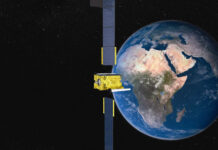The Starlink satellite communications network is on track to provide global broadband connectivity. Starlink is also emerging as a promising passive radar technology.
SpaceX’s Starlink Satellite Communications (SATCOM) system dramatically entered the news, and the public consciousness, on 26th February 2022. Two days before, Russia’s President Vladimir Putin had ordered his second invasion of Ukraine. The first had come almost exactly eight years earlier, during which Russia occupied Ukraine’s southern Crimea region and parts of her eastern Donbass area. SpaceX began supplying thousands of Starlink terminals to Ukraine, which have aided civilian and military communications.
Coincidentally, SpaceX began development of the Starlink network in 2014; the same year as Putin’s occupation of Ukraine’s Crimea and Donbas. Starlink intends to provide global, broadband communications using a constellation of thousands of low Earth orbit (LEO) satellites. LEO spacecraft typically orbit Earth at altitudes not exceeding 2,000 km (1,080 NM), though Starlink satellites tend to sit at the lower end of this band, at around 550 km altitude. Starlink’s global coverage is possible because of the large number of satellites in orbit which, as of April 2024, comprised around 5,721 operational satellites, according to reports. SpaceX’s plans call for an eventual 12,000 satellites to be in orbit, possibly eventually increasing this to 42,000. By the end of 2023, SpaceX had two million subscribers, reports continued. The company’s own maps show that Starlink provides coverage over almost all of Europe, all north and central America, and most of South America. Australasia enjoys coverage, as does Mongolia, Japan, parts of southeast Asia and parts of western and southern Africa. SpaceX has not disclosed when it hopes to provide global Starlink coverage although this could probably be achieved by 2030 depending on the frequency of satellite launches.

Credit: Jud McCranie
Users must possess Starlink terminals to access the network which employs an array of wavebands between 10.7 GHz to 51.4 GHz, public records note. Some of these wavebands are used by the terminals to transmit traffic up to the satellites. Other wavebands are used by the satellite to send traffic to Earth. Frequencies of 10.7 GHz to 12.7 GHz let the satellites send traffic to user terminals while frequencies of 17.8 GHz to 18.6 GHz, 18.8 GHz to 19.3 GHz and 37.5 GHz to 42.5 GHz connect the satellites to gateways. Gateways connect terminal users to websites and internet services they wish to access. For example, a person may be using a terminal to access weather reports. They send their request to access a website, via the satellite, to the gateway. The gateway connects with the desired website, hence connecting the user. A host of other wavebands connect the gateways and terminals to the satellites, or connect the satellite to Earth and vice versa so that the spacecraft can be monitored and controlled.
The eventual global coverage afforded by the thousands LEO satellites will envelop the planet in a blanket of satellite-to-Earth signals. Once the roll-out of the Starlink network and satellites is complete, all Starlink users will be able to have broadband access wherever they are. As this article will show, this presents certain opportunities for passive radar innovators.
Active vs passive
To understand passive radar, and the role Starlink could play in this technology, it is necessary to understand how conventional, or active, radar works. Radars exploit radio signals to detect, locate, identify and track targets. A radar transmits a pulse or wave of radio frequency (RF) energy which travels at the speed of light – 299,274,458 m/s. The RF leaves the radar’s antenna, travels through the ether, hits a target and is reflected. By measuring, and halving, the time taken for the RF energy to leave the radar, hit the target and return, the target’s range can be determined. If the RF energy’s entire journey (antenna-target-antenna) takes 0.0005 seconds, the energy has travelled circa 149.6 km (80.8 NM). Divide this by two and the target is determined as being 74.8km (40.4 NM) away.
Radars also exploit the Doppler effect. A target in motion will slightly change the frequency of the radar echo when moving towards or away from the antenna. An oft-quoted example of this phenomena is the apparent rise and fall of a police car’s siren. When the police car approaches a stationary observer the siren seems to rise in tone, and conversely, the siren falls in tone as the car drives away. In reality the frequency of the siren is unchanged, but to the stationary observer it appears to rise as it approaches. This is because the peaks and troughs comprising the soundwave take progressively less time to arrive as the distance between the observer and police car decreases. The opposite is true as the siren moves away. Suppose we have a radar which is transmitting a signal on a frequency of 8.20 GHz, and the signal hits a target travelling at 235.2 km/h (127 kn), and the recorded frequency of the radar echo is 8.19 GHz. This indicates that the target is in motion, moving away from the radar. Continuously monitoring this change in frequency allows the radar to determine the target’s motion relative to the radar’s position.
Active radars have one major disadvantage. As they emit an RF signal, technically anyone with a radio receiver covering the frequency of this signal can detect it, and hence the radar. If you detect the signal you can determine its line-of-bearing relative to your own position if you have a single receiving antenna. If you have two or more receiving antennas, you can triangulate the radar’s location. In a military context, this can be dangerous. If you know where the radar is, you could potentially destroy it with ordnance. This inherent risk is because conventional radars generate and transmit their own RF energy.
Passive radars work slightly differently, because they do not generate RF energy, but instead rely on interpreting changes to RF signals already present in the radar’s locale. This avoids the radar having to transmit its own signals and thus potentially risk becoming a target. You may not be aware of it, but you are continually surrounded by RF energy, particularly if you live in a built-up area. Radio and television broadcasting and cellphone coverage are two of the most prevalent RF sources. Passive radars will closely watch what is happening to particular RF signals across a specific area.

Credit: Thomas Withington
By way of example, Digital Video Broadcasting-Terrestrial (DVB-T), is used across much of the world for television transmissions. The International Telecommunications Union (ITU) reserves several frequencies for DVB-T use. The ITU is the United Nations organisation tasked with the global governance of the radio spectrum. Frequencies of 174 MHz to 786 MHz are retained for national DVB-T use. A passive radar will listen and sample a ‘pure’ DVB-T signal using an antenna which is within range of the DVB-T transmitter and store the information on the signal’s characteristics. This first antenna provides the reference signal. An additional antenna, or several antennas, will monitor the same local DVB-T signals. These antennas are used to determine if there is any frequency change compared to the sampled pure signal. Aircraft flying through these DVB-T signals will create slight disturbances, as the signals collide with the planes and are reflected. By comparing the two signals it is possible for a passive radar to determine that an airborne target is out there. Additional processing can help determine the target’s behaviour such as its speed and/or direction of movement.
Exploiting local RF signals frees passive radars from depending on an internal RF source to illuminate a target, and the inherent risks this might bring. Nonetheless, RF signals are not necessarily ubiquitous. For example, cellphone and DVB-T coverage will be spartan at best over the oceans. Radio signals tend to follow a line-of-sight range. Even cellphone towers by the coast transmit signals that eventually run out of power over the sea and technically continue in a straight line, moving out into space, away from the curvature of the Earth. The attraction of using Starlink’s signals as a passive radar RF source is that they will soon be available worldwide.
Harnessing Starlink
Using Starlink in this way is not merely a theoretical idea. Research is advancing to employ Starlink downlink signals as an RF source for passive radar. In late January 2024, Germany’s Ministry of Defence announced that the country was developing a passive radar which could exploit Starlink’s signals. The work is being performed by Germany’s Fraunhofer Institute for High Frequency Physics and Radar Techniques (FHR). Reports stated that the system uses a reference antenna which follows Starlink satellites as they cross the sky. The reference antenna detects and copies the signal’s characteristics as these are beamed down to Earth. A second antenna is pointed towards the area of interest the radar is monitoring. The reference signal is compared with those signals coming into the second antenna. This process ascertains if these signals are being altered by targets in the antenna’s field of view.

Credit: Fraunhofer FHR
One consideration for the Fraunhofer Institute’s passive radar, known as Sabbia-2.0, is that any individual Starlink satellite will only be visible for a finite amount of time as the spacecraft crosses the horizon. The LEO satellites comprising the Starlink network are continuously moving across the sky. This is unlike geostationary Earth orbit (GEO) satellites which orbit in such a way as to always appear at the same location above Earth’s equator. Open sources say that Starlink satellites orbit the Earth at speeds of 25,200 km/h (13,607 kn), so each satellite is ‘visible’ to an antenna on the ground for four minutes and 29 seconds as it crosses the horizon. In order to work, the passive radar’s antenna must first acquire the satellite as soon as it appears in its field of view. The radar must then sample the satellite’s downlink signals and copy these while continually tracking the satellite. As soon as that satellite is no longer visible, the second antenna must acquire the following satellite and repeat the process. It is necessary for this process to be as seamless as possible to ensure the radar’s smooth operation.
Refining the design
Fraunhofer’s representatives told this correspondent that the institute has been working on passive radar for over a decade. Initially, efforts focused on harnessing DVB-T signals as the RF source. Recent years have seen research expand into the use of satellite-based sources, particularly RF signals from geostationary spacecraft. One of the attractions of using space-based RF sources is the availability of downlink signals. The abundance of terrestrial RF tends to diminish in frequencies above ten gigahertz. However, satellite downlink frequencies exist in X-band (7.25-7.75 GHz), Ku-band (10.9-12.75 GHz) and Ka-band (18-20 GHz). As Starlink is showing, some of these wavebands could soon have ubiquitous global availability. Employing satellite RF sources is particularly attractive when you want to use a passive radar over the oceans. Fraunhofer has already developed passive radar technology to exploit 10.75-12.75 GHz Digital Video Broadcasting-Satellite (DVB-S) signals. The OneWeb broadband SATCOM network’s frequencies of 12 GHz to 18 GHz have also proved useful.
“We started looking at Starlink about five years ago as a potential illuminator, and we have been developing things over the last four years,” said Dr. Rodrigo Blázquez García, a radar engineer in the Fraunhofer Institute’s FHR department. Realising a passive radar which can exploit RF signals from constellations such as Starlink brings unique challenges, noted Dr. Blázquez García: “The satellites are always moving … We needed to be able to predict where the satellites are at any specific time.” Fortunately, information is available in public sources on the position and velocities of individual satellites at any time. A key attraction of Starlink is the large number of satellites supporting the network. Before the advent of these constellations, “there had only been single or twin satellites which might pass over the horizon very quickly,” said Professor Daniel O’Hagan, FHR’s chief scientist at the defence business unit at Fraunhofer FHR: “Starlink and other constellations are much more numerous, providing us with a continual RF transmission source in space.”

Credit: Fraunhofer FHR
The movement of the RF transmitter means that imagery of still and moving targets can be processed. When coupled with the characteristics of Starlink’s downlink frequencies, this movement helps provide a target resolution of circa one metre. Generally speaking in radar engineering, the higher the frequency, the sharper the target resolution. As the satellites are moving through the skies, they will cover a target on Earth with RF signals which are captured by Sabbia-2.0’s antenna. The fact that targets can be shown in such impressive detail is the result of satellites’ motions. The signal is transmitted from the satellite and hits a target. The echo of the signal from the target causes the signal’s frequency to change vis-à-vis the reference signal. Each signal disturbance allows the radar to build up a more detailed target picture. The more times the signals repeat this behaviour per second, the richer the information becomes regarding the target the signals collide with. As the satellite is crossing the sky, the signals collide with the target at a myriad of different angles. This process is analogous to you watching an object revolving on a turntable. Your brain gathers more information as the object rotates, compared to only seeing the object once when stationary. For all intents and purposes, the satellite is the eye in the sky and the Earth is the turntable.
The entire Sabbia-2.0 architecture can weigh as little at 60 kg (132 lb), meaning that it can be easily accommodated on a vehicle. Other applications are being considered for the technology. For example, Sabbia-2.0 could be configured to outfit a ship or aircraft. Once in situ, the antennas supporting the system can be positioned in such a way as to ensure that the system works as efficiently as possible. The Sabbia-2.0 antennas are electronically steered which helps track satellite signals more efficiently than using a mechanically-scanned one.
Dr. Diego Cristallini, the FHR’s group leader for passive covert radar, expected demonstrations of the Sabbia-2.0 architecture using Starlink and OneWeb signals to be performed in the coming months of 2024. Prof. O’Hagen said that Sabbia-2.0 is already developed to Technology Readiness Level Six (TRL-6). According to European Union definitions, TRL-6 denotes that “technology has been demonstrated in a relevant environment.” The FHR typically performs research and development up to TRL-6. Taking the technology beyond this would need to be done in partnership with the private sector.

Credit: Fraunhofer FHR
Immediate plans call for the technology to be mounted on a trailer to show that the passive radar can be used onboard a moving platform. “The project’s next steps are proceeding very satisfactorily,” said O’Hagen, adding, “there is a lot of interest from multiple parties.” The thoughts of Prof. O’Hagen and his colleagues are also turning to whether Starlink could be used for other purposes. One area of interest is using the network as a Global Navigation Satellite System (GNSS) alternative. Expect Fraunhofer’s engineers to potentially find other applications beyond passive radar and GNSS as Starlink’s rollout gathers momentum.
Thomas Withington








![Connect-4 The European Super RAP developed by NATO’s ACCS is shared with NATO’s Allied Air Command headquarters in Ramstein, western Germany. Two CAOCS, controlling NATO airspace above northern and southern Europe, generate these RAPs. [NATO]](https://euro-sd.com/wp-content/uploads/2025/06/NATO-Allied-Air-Command-NATO-Kopie-218x150.jpg)






